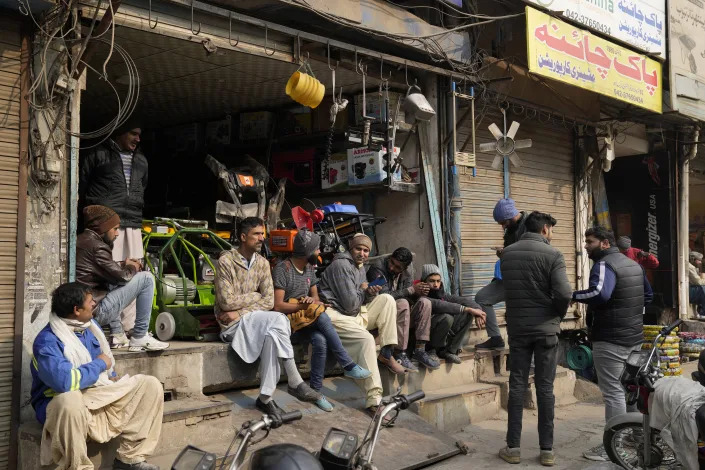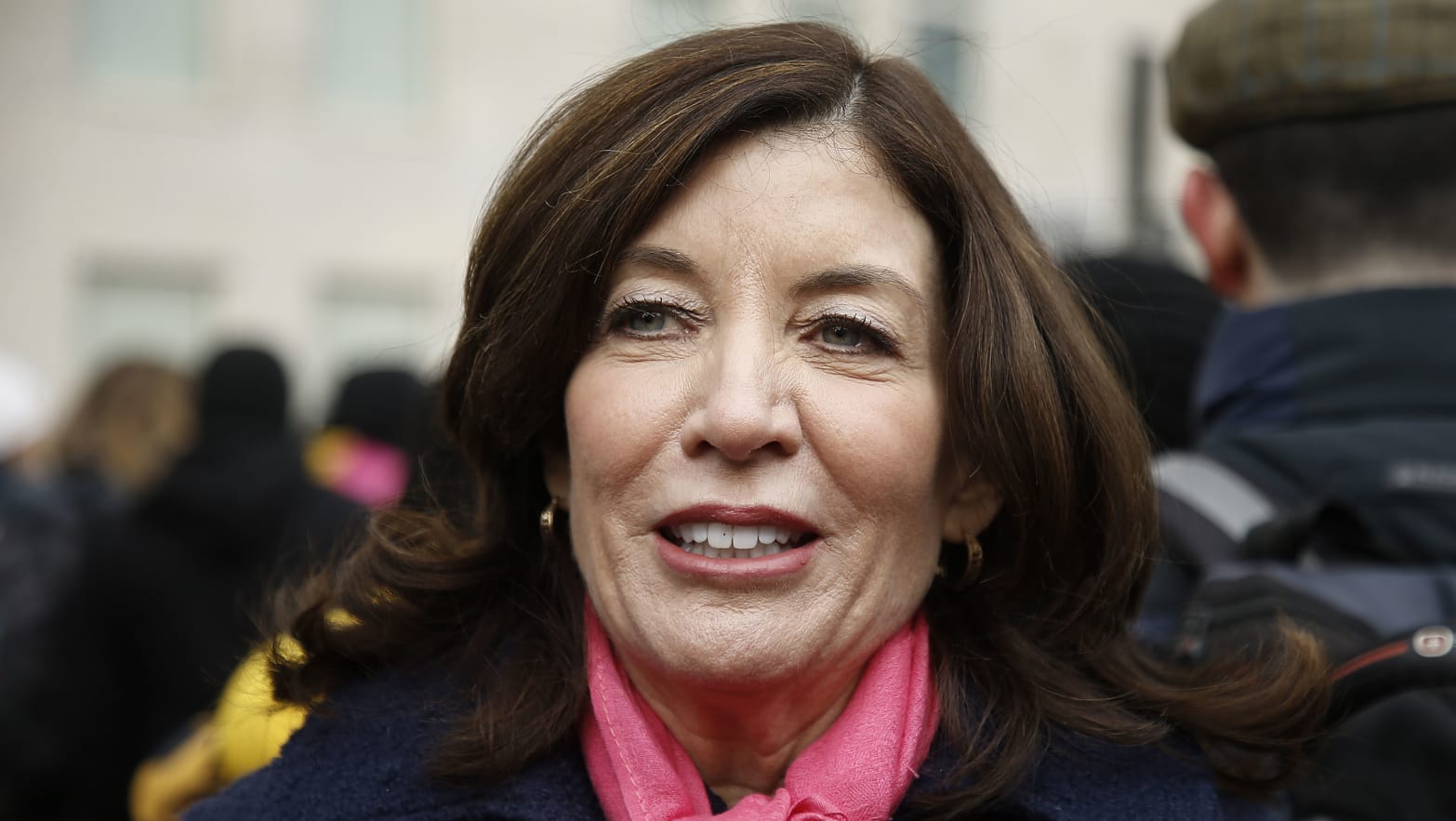FAILED STATE
Lights out in Pakistan as energy-saving move backfires


A shopkeeper use a battery light at his mobile selling shop to deal customers during a national-wide power breakdown, in Islamabad, Pakistan, Monday, Jan. 23, 2023. Much of Pakistan was left without power Monday as an energy-saving measure by the government backfired. The outage spread panic and raised questions about the cash-strapped government's handling of the country's economic crisis.
(AP Photo/Anjum Naveed)
MUNIR AHMED
Mon, January 23, 2023
ISLAMABAD (AP) — Most of Pakistan was left without power Monday as an energy-saving measure by the government backfired. The outage spread panic and raised questions about the cash-strapped government’s handling of the country's economic crisis.
It all started when electricity was turned off during low usage hours overnight to conserve fuel across the country, officials said, leaving technicians unable to boot up the system all at once after daybreak. The outage was reminiscent of a massive blackout in January 2021, attributed at the time to a technical fault in Pakistan's power generation and distribution system.
Many major cities, including the capital of Islamabad, and remote towns and villages across Pakistan were without electricity for more than 12 hours. As the electricity failure continued into Monday night, authorities deployed additional police at markets around the country to provide security.
Officials announced late Monday that power was restored in many cities, 15 hours after the outage was reported.
Earlier, the nationwide electricity breakdown left many in this country of some 220 million people without drinking water as pumps powered by electricity failed to work. Schools, hospitals, factories and shops were without power amid the harsh winter weather.
Energy Minister Khurram Dastgir told local media that engineers were working to restore power across the country and tried to reassure the nation that power would be fully restored within the next 12 hours.
According to the minister, electricity usage typically goes down overnight during winter — unlike summer months when Pakistanis turn to air conditioning, seeking a respite from the heat.
“As an economic measure, we temporarily shut down our power generation systems" Sunday night, Dastgir said. When engineers tried to turn the systems back on, a “fluctuation in voltage" was observed, which “forced engineers to shut down the power grid" stations one by one.
Dastgir insisted the outage did not constitute a major crisis and that electricity was being restored in phases. In many places and key businesses and institutions, including hospitals, military and government facilities, backup generators kicked in.
By late afternoon Monday, Dastgir told reporters at another press conference that Prime Minister Shahbaz Sharif ordered a probe into the outage.
“We are hoping that the supply of electricity will be fully restored tonight,” he said.
Before midnight, power was back in Karachi, the country's largest city and economic hub, and in many other major cities including Rawalpindi, Quetta, Peshawar and Lahore, the capital of eastern Punjab province.
In Lahore, a closing notice was posted on the Orange Line metro stations, with rail workers guarding the sites and trains parked on the rails. It was unknown when the metro system would be restored.
Imran Rana, a spokesperson for Karachi's power supply company, said the government's priority was to restore power first to strategic facilities, including hospitals and airports.
Internet-access advocacy group NetBlocks.org said network data showed a significant decline in internet access in Pakistan that was attributed to the power outage. It said metrics indicated that connectivity was at 60% of ordinary levels as many users struggled to get online Monday.
Pakistan gets at least 60% of its electricity from fossil fuels, while nearly 27% of the electricity is generated by hydropower. The contribution of nuclear and solar power to the nation's grid is about 10%.
Pakistan is grappling with one of the country's worst economic crisis in recent years amid dwindling foreign exchange reserves. That has compelled the government to order shopping malls and markets closed by 8:30 p.m. to conserve energy.
Talks are underway with the International Monetary Fund to soften some conditions on Pakistan’s $6 billion bailout, which the government thinks will trigger further inflation hikes. The IMF released the last crucial tranche of $1.1 billion to Islamabad in August.
Since then, discussions between the two parties have oscillated due to Pakistan's reluctance to impose new tax measures.
___
Associated Press writer Jon Gambrell in Dubai, United Arab Emirates, contributed to this report.
MUNIR AHMED
Mon, January 23, 2023
ISLAMABAD (AP) — Most of Pakistan was left without power Monday as an energy-saving measure by the government backfired. The outage spread panic and raised questions about the cash-strapped government’s handling of the country's economic crisis.
It all started when electricity was turned off during low usage hours overnight to conserve fuel across the country, officials said, leaving technicians unable to boot up the system all at once after daybreak. The outage was reminiscent of a massive blackout in January 2021, attributed at the time to a technical fault in Pakistan's power generation and distribution system.
Many major cities, including the capital of Islamabad, and remote towns and villages across Pakistan were without electricity for more than 12 hours. As the electricity failure continued into Monday night, authorities deployed additional police at markets around the country to provide security.
Officials announced late Monday that power was restored in many cities, 15 hours after the outage was reported.
Earlier, the nationwide electricity breakdown left many in this country of some 220 million people without drinking water as pumps powered by electricity failed to work. Schools, hospitals, factories and shops were without power amid the harsh winter weather.
Energy Minister Khurram Dastgir told local media that engineers were working to restore power across the country and tried to reassure the nation that power would be fully restored within the next 12 hours.
According to the minister, electricity usage typically goes down overnight during winter — unlike summer months when Pakistanis turn to air conditioning, seeking a respite from the heat.
“As an economic measure, we temporarily shut down our power generation systems" Sunday night, Dastgir said. When engineers tried to turn the systems back on, a “fluctuation in voltage" was observed, which “forced engineers to shut down the power grid" stations one by one.
Dastgir insisted the outage did not constitute a major crisis and that electricity was being restored in phases. In many places and key businesses and institutions, including hospitals, military and government facilities, backup generators kicked in.
By late afternoon Monday, Dastgir told reporters at another press conference that Prime Minister Shahbaz Sharif ordered a probe into the outage.
“We are hoping that the supply of electricity will be fully restored tonight,” he said.
Before midnight, power was back in Karachi, the country's largest city and economic hub, and in many other major cities including Rawalpindi, Quetta, Peshawar and Lahore, the capital of eastern Punjab province.
In Lahore, a closing notice was posted on the Orange Line metro stations, with rail workers guarding the sites and trains parked on the rails. It was unknown when the metro system would be restored.
Imran Rana, a spokesperson for Karachi's power supply company, said the government's priority was to restore power first to strategic facilities, including hospitals and airports.
Internet-access advocacy group NetBlocks.org said network data showed a significant decline in internet access in Pakistan that was attributed to the power outage. It said metrics indicated that connectivity was at 60% of ordinary levels as many users struggled to get online Monday.
Pakistan gets at least 60% of its electricity from fossil fuels, while nearly 27% of the electricity is generated by hydropower. The contribution of nuclear and solar power to the nation's grid is about 10%.
Pakistan is grappling with one of the country's worst economic crisis in recent years amid dwindling foreign exchange reserves. That has compelled the government to order shopping malls and markets closed by 8:30 p.m. to conserve energy.
Talks are underway with the International Monetary Fund to soften some conditions on Pakistan’s $6 billion bailout, which the government thinks will trigger further inflation hikes. The IMF released the last crucial tranche of $1.1 billion to Islamabad in August.
Since then, discussions between the two parties have oscillated due to Pakistan's reluctance to impose new tax measures.
___
Associated Press writer Jon Gambrell in Dubai, United Arab Emirates, contributed to this report.






Pakistan power grid hit by nationwide breakdown with outages in all major cities

Pakistan power grid hit by nationwide breakdown with outages in all major cities
Shweta Sharma
Mon, January 23, 2023
Much of Pakistan was left without power for several hours on Monday morning after an energy-saving measure by the government backfired.
Electricity was turned off across the country during low usage hours overnight to conserve fuel, leaving the grid unable to meet demand at daybreak, officials said.
Mobile phone masts and airports were among the facilities left without power, causing wider chaos.
The outage spread panic and raised questions about the cash-strapped government's handling of the crisis.
Blackouts were reported in most cities including Karachi, Quetta, Peshawar and Lahore.
Supply to some areas has been suspended by up to 90 per cent, according to initial reports.
The contry’s energy ministry said the system frequency of the national grid was reduced at around 7.34am on Monday, which resulted in “widespread breakdown in the power system”.
“System maintenance work is progressing rapidly,” it said in a tweet.
Electricity supplies are regularly cut off across the country during low usage hours overnight, especially during winters, to conserve fuel. Pakistan’s power minister Khurrum Dastagir confirmed to Geo News that power generation units had been temporarily shut down on Sunday night as a fuel-preserving measure, with the country reeling from an ongoing economic crisis.
Officials said that when technicians went to turn on the system after daybreak, the network failed.
Mr Dastagir denied it was a “major crisis”.
“When the systems were turned on at 7.30am this morning one by one, frequency variation was reported in the southern part of the country between Jamshoro and Dadu. There was a fluctuation in voltage and the systems were shut down one by one,” said Mr Dastagir.
After 10am local time, the energy ministry said in an update that restoration work on the power grids had begun and some grids, including those operated by the Islamabad Supply Company and Peshawar Supply Company, had been at least partially restored.
More than six hours later with key facilities including factories, hospitals and schools grinding to a halt due to the outage, Mr Dastagir told Reuters supplies were partially restored and engineers are working to restore the grid fully by 10pm local time.
“We are trying our utmost to achieve restoration before that.”
He added that power had been partially restored in Islamabad, Peshawar, Multan and Sukkur.
Videos on social media showed a train stuck on a bridge and passengers trapped inside walking on foot on the tracks.
The Civil Aviation Authority said there were significant issues from power outages at airports across the country, though backup systems mean the situation was “under control”.
“The situation is under control thanks to the alternative systems. We are using standby power to provide uninterrupted electricity to all the airports,” the authority’s spokesperson said in a statement.
Several private power distribution companies also confirmed the breakdown at their end amid massive power outages across the country.
The Quetta Electric Supply Company (QESCO) said two transmission lines in towns between Sindh province and Quetta had tripped. It said that 22 districts of Balochistan, including Quetta itself, are without power.
The Islamabad Electric Supply Company said 117 grid stations were without electricity, adding that “no clear reason has been given by the Region Control Center”.
In the first week of January, authorities in Pakistan ordered shopping malls and markets to close by 8.30pm as part of a new energy conservation plan aimed at easing Pakistan‘s economic crisis.
Pakistan is grappling with one of the country’s worst domestic and foreign financial crises following unprecedented floods last year and dwindling foreign exchange reserves.
The government is attempting to save energy and curtail the costs of imported oil, on which Pakistan spends $3bn annually. Most of Pakistan’s electricity is generated by using imported oil.
It gets at least 60 per cent of its electricity from fossil fuels, while nearly 27 per cent of the electricity is generated by hydropower. The contribution of nuclear and solar power to the nation’s grid is about 10 per cent.
The cash-strapped nation is also in talks with IMF to soften some conditions on its $6bn bailout deal, which the government thinks will cause a further increase in inflation.
A similar power outage occurred in Pakistan in October 2022, when a large part of the country was without electricity for almost 12 hours.

Pakistan power grid hit by nationwide breakdown with outages in all major cities
Shweta Sharma
Mon, January 23, 2023
Much of Pakistan was left without power for several hours on Monday morning after an energy-saving measure by the government backfired.
Electricity was turned off across the country during low usage hours overnight to conserve fuel, leaving the grid unable to meet demand at daybreak, officials said.
Mobile phone masts and airports were among the facilities left without power, causing wider chaos.
The outage spread panic and raised questions about the cash-strapped government's handling of the crisis.
Blackouts were reported in most cities including Karachi, Quetta, Peshawar and Lahore.
Supply to some areas has been suspended by up to 90 per cent, according to initial reports.
The contry’s energy ministry said the system frequency of the national grid was reduced at around 7.34am on Monday, which resulted in “widespread breakdown in the power system”.
“System maintenance work is progressing rapidly,” it said in a tweet.
Electricity supplies are regularly cut off across the country during low usage hours overnight, especially during winters, to conserve fuel. Pakistan’s power minister Khurrum Dastagir confirmed to Geo News that power generation units had been temporarily shut down on Sunday night as a fuel-preserving measure, with the country reeling from an ongoing economic crisis.
Officials said that when technicians went to turn on the system after daybreak, the network failed.
Mr Dastagir denied it was a “major crisis”.
“When the systems were turned on at 7.30am this morning one by one, frequency variation was reported in the southern part of the country between Jamshoro and Dadu. There was a fluctuation in voltage and the systems were shut down one by one,” said Mr Dastagir.
After 10am local time, the energy ministry said in an update that restoration work on the power grids had begun and some grids, including those operated by the Islamabad Supply Company and Peshawar Supply Company, had been at least partially restored.
More than six hours later with key facilities including factories, hospitals and schools grinding to a halt due to the outage, Mr Dastagir told Reuters supplies were partially restored and engineers are working to restore the grid fully by 10pm local time.
“We are trying our utmost to achieve restoration before that.”
He added that power had been partially restored in Islamabad, Peshawar, Multan and Sukkur.
Videos on social media showed a train stuck on a bridge and passengers trapped inside walking on foot on the tracks.
The Civil Aviation Authority said there were significant issues from power outages at airports across the country, though backup systems mean the situation was “under control”.
“The situation is under control thanks to the alternative systems. We are using standby power to provide uninterrupted electricity to all the airports,” the authority’s spokesperson said in a statement.
Several private power distribution companies also confirmed the breakdown at their end amid massive power outages across the country.
The Quetta Electric Supply Company (QESCO) said two transmission lines in towns between Sindh province and Quetta had tripped. It said that 22 districts of Balochistan, including Quetta itself, are without power.
The Islamabad Electric Supply Company said 117 grid stations were without electricity, adding that “no clear reason has been given by the Region Control Center”.
In the first week of January, authorities in Pakistan ordered shopping malls and markets to close by 8.30pm as part of a new energy conservation plan aimed at easing Pakistan‘s economic crisis.
Pakistan is grappling with one of the country’s worst domestic and foreign financial crises following unprecedented floods last year and dwindling foreign exchange reserves.
The government is attempting to save energy and curtail the costs of imported oil, on which Pakistan spends $3bn annually. Most of Pakistan’s electricity is generated by using imported oil.
It gets at least 60 per cent of its electricity from fossil fuels, while nearly 27 per cent of the electricity is generated by hydropower. The contribution of nuclear and solar power to the nation’s grid is about 10 per cent.
The cash-strapped nation is also in talks with IMF to soften some conditions on its $6bn bailout deal, which the government thinks will cause a further increase in inflation.
A similar power outage occurred in Pakistan in October 2022, when a large part of the country was without electricity for almost 12 hours.

















